
- Abruzzo NP - Italy
- Alaska
- Alaska - Southeast
- Alberta - Canada
- Amazon (Brazil)
- American Samoa
- Angola
- Antarctica - Emperor Penguins
- Antarctica
- Arctic Canada
- Arctic Russia
- Argentina - North
- Argentina - South
- Atlantic Odyssey
- Arizona - Southeast
- Australia - East
- Australia - North
- Australia - Northwest
- Australia - Outback
- Australia - Southeast
- Australia - West
- Austria
- Azores
- Baffin Island
- Bahamas
- Baja California
- Beidaihe - China
- Belarus
- Belize
- Bhutan
- Borneo
- Bolivia
- Bosque del Apache (New Mexico)
- Botswana
- Brazil - Amazon
- Brazil - Central
- Brazil - Cristalino Lodge
- Brazil - Northeast
- Brazil - Pantanal
- Brazil - Southeast
- British Columbia
- Bulgaria
- California - Northern
- California - Southern
- Cambodia
- Cameroon
- Canada - Alberta
- Canada - Arctic
- Canada - Baffin Island
- Canada - East
- Canada - Manitoba
- Canada - Newfoundland
- Canada - Point Pelee
- Canada - Quebec
- Canada - West
- Canary Islands
- Cape May - New Jersey
- Cape Verde Islands
- Cayman Islands
- Central African Rep.
- Chile
- China - Beidaihe
- China - Central
- China - East (Poyang Hu)
- China - Hong Kong
- China - Sichuan
- China - Yunnan
- Christmas Island
- Colombia
- Colorado - USA
- Cook Islands
- Corsica
- Costa Rica
- Croatia
- Cuba
- Czech Republic
- Dominica
- Dominican Republic
- Ecuador - North
- Ecuador - South
- Egypt
- El Triunfo - Mexico
- Emperor Penguins
- Estonia
- Ethiopia
- Extremadura - Spain
- Falkland Islands
- Fiji
- Finland & Norway
- Florida - USA
- France - South
- French Polynesia
- Gabon
- Galapagos
- Gambia
- Georgia
- Ghana
- Goa, India
- Greece
- Guatemala
- Guyana
- Halmahera
- Hange Tham - Nepal
- Hawaii
- Hebrides (Outer)
- Holland
- Honduras
- Hong Kong
- Hungary
- Iceland
- India - Goa
- India - Northeast
- India - North
- India - Northwest
- India - South
- India - West
- Indonesia - Java
- Indonesia - Komodo
- Indonesia - Lesser Sundas
- Indonesia - Sulawesi and Halmahera
- Indonesia - Sumatra
- Indonesia - West Papua
- Iran
- Israel
- Italy - Abruzzo NP
- Jamaica
- Japan
- Java
- Kamchatka
- Kazakhstan
- Kenya
- Komodo
- Ladakh
- Lesser Sundas
- Lesvos
- Madagascar
- Madeira
- Maine
- Malaysia - Borneo
- Malay Peninsula
- Malawi
- Maldives
- Manitoba - Canada
- Manu - Peru
- Massachusetts
- Mauritius
- Mexico - Baja
- Mexico - Central
- Mexico - El Triunfo
- Mexico - Oaxaca
- Mexico - Southern
- Mexico - Veracruz
- Mexico - Western
- Micronesia - Palau & Yap
- Minnesota
- Mongolia
- Morocco - South
- Mozambique
- Mull (& Scottish Highlands)
- Myanmar
- Namibia
- Nebraska (Platte River)
- Nepal
- Nepal - Hange Tham
- Netherlands
- New Brunswick
- New Caledonia
- Newfoundland
- New Mexico (Bosque del Apache)
- New Zealand
- New Zealand - Subantarctic Islands
- North Carolina
- North Dakota
- Norway - Arctic
- Nova Scotia
- Oaxaca - Mexico
- Oman
- Ontario (Point Pelee)
- Oregon
- Outer Hebrides
- (Western) Pacific Odyssey
- Palau & Yap
- Panama
- Pantanal - Brazil
- Papua New Guinea
- Paraguay
- Peru - Central
- Peru - North
- Peru - Northeast
- Peru - Manu
- Philippines
- Platte River (Nebraska)
- Point Pelee (Ontario)
- Poland
- Polynesia
- Portugal
- Poyang Hu - China
- Puerto Rico
- Quebec
- Queensland
- Reunion
- Romania
- Russia - Arctic
- Russia - Kamchatka
- Rwanda
- St Lucia
- Samoa
- Sao Tome & Principe
- Scotland - Highlands & Mull
- Scotland - Outer Hebrides
- Scotland - Shetland
- Senegal
- Seychelles
- Shetland - Scotland
- Sichuan - China
- Sierra Leone
- Solomon Islands
- South Africa - East
- South Africa - West
- South Georgia
- Spain - Extremadura
- Spain - North
- Spain - Northwest
- Spain - South
- Spitsbergen (Svalbard)
- Sri Lanka
- Subantarctic Islands
- Sulawesi
- Sumatra
- Suriname
- Sweden
- Taiwan
- Tanzania - North
- Tanzania - South
- Tasmania
- Texas
- Thailand - North
- Thailand - South
- Tibet
- Trinidad & Tobago
- Tonga
- Turkey
- Uganda
- Ukraine
- USA - Alaska
- USA - Alaska - Southeast
- USA - Arizona - Southeast
- USA - Bosque del Apache
- USA - California - North
- USA - California - South
- USA - Cape May
- USA - Colorado
- USA - Florida
- USA - Hawaii
- USA - Maine
- USA - Massachusetts
- USA - Minnesota
- USA - North Carolina
- USA - North Dakota
- USA - Oregon
- USA - Platte River
- USA - Texas
- USA - Washington
- USA - Wyoming (Yellowstone)
- Vanuatu
- Venezuela - East
- Venezuela - West
- Veracruz - Mexico
- Vietnam
- Washington
- Western Pacific Odyssey
- Western Sahara
- (Western) Samoa
- West Papua
- Wyoming (Yellowstone)
- Yap & Palau
- Yunnan - China
- Zambia
DESTINATION
A-Z
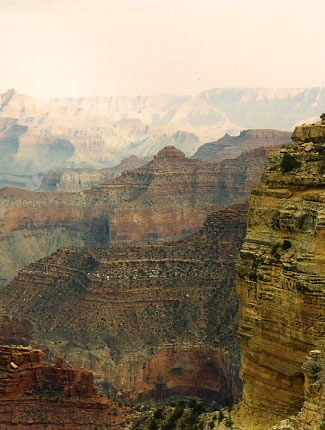
The Grand Canyon by Nigel Wheatley.
BEST 50 other NATURAL WONDERS
The Earth is alive. 200 million years ago when the first mammals evolved all land was gathered together in one continent known as Pangaea. This began to break up 20 million years later and during the course of the last 180 million years the land split and spread out across the surrounding Panthalassa Ocean into the seven continents which currently exist. In 200 million years time this list of the Earth's Natural Wonders (apart from wildlife) will be completely different, because the six large and several smaller plates the land lies on are constantly on the move, conveyed by the energy generated in the Earth’s molten core by the disintegration of radioactive elements. The heat, about 7770 Fahrenheit, keeps the planet’s mantle as a mixture of liquid magma and rocks; a thick, viscous current. Floating on this swirling inferno is the Earth’s crust, the major parts of which, known as tectonic plates, are drifting about, pulling some continents apart and pushing others together, widening oceans and building mountains, the rocks of which are worn down by ice and heat and rain and wind, so that granite becomes clay and sand, and this is washed down to the seabed where the fine grains are then compressed into new rocks which are eventually pushed up above the sea, and so the process of construction and destruction goes on, as it has done for billions of years, for all the picture of our planet in our mind’s eye shows is one tenth of one percent of the history of Earth.
This list is therefore not only highly subjective but temporary. However, these wonders are the ones we believe are the best in the world at this moment in time. They have been chosen very carefully and for a multitude of reasons, but mainly based on personal experience of some of them and on dreams of seeing the rest, dreams resulting from what we have heard, read or seen. Email us which wonders you think should be on the list.
After worldwide phenomena the wonders are listed continent by continent. The list does not include wildlife, including birds. They are dealt with separately under Top 100 Birds and Top 100 Other Wildlife. For more information also see the Destinations A-Z.
The List
Sunrises and Sunsets
These can be spectacular anywhere.
Rainbows
To see a rainbow the Sun, which must not be too high, needs to be behind the observer and rain needs to be falling
in front. The raindrops reflect and refract (bend) each wavelength of the Sun’s ‘white’ light at slightly different angles so that each one leaves
the raindrop as a different colour and the bigger the raindrops (such as those in a cumulonimbus or ‘thundercloud’) the sharper and brighter the
rainbow. Sometimes rainbows form around the Sun or even the Moon, when there is a thin layer of high-level cirrus or cirro-stratus clouds which are
composed of ice crystals.
Thunder and Lightning
Moist warm air rises and cools then condenses to form a cumulus cloud. If the difference in temperature
is great enough between the cloud’s upper and lower levels, the cloud keeps increasing in size, possibly growing up to 7 km (4.4 miles) from top to
bottom. It develops the spreading anvil-shaped head of a cumulonimbus with a positive charge at the top and a negative one at the bottom, and,
eventually the electricity leaps from one charge to the other, producing lightning. The flash heats the air to temperatures near 18,000 Fahrenheit
(10,000 Celsius), a sudden expansion of hot air which is heard a few seconds later as thunder.
Eclipses
A Solar Eclipse is when the Moon comes between the Earth and the Sun and darkness descends during daylight and with
protective glasses it is possible to see what looks like a diamond ring in the sky as the surface of the Sun flares behind the Moon. A Lunar Eclipse
is when the Earth comes between the Sun and the Moon.

Partial solar eclipse, Cornwall, England, March 2015, by Nigel Wheatley.
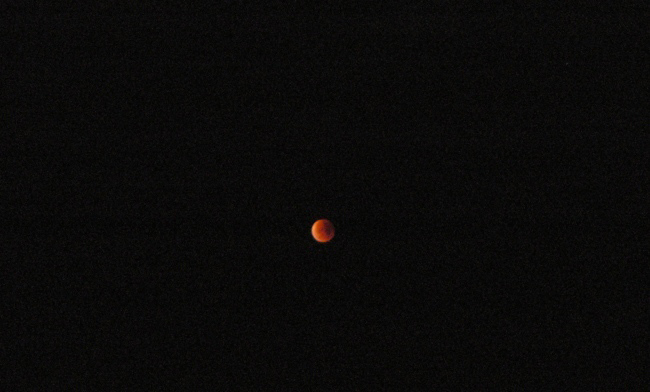
Lunar eclipse, Cornwall, England, September 2015, by Alice Perry.
Aurora Borealis and Aurora Australis (Northern and Southern Lights)
These natural light shows are spectacular, painting the skies
with 'Curtains', arcs and flashes of blue, green, red, yellow or violet. NASA scientists believe they will be the brightest for fifty years in 2012,
because they are loosely linked to the Solar Activity Cycle which usually lasts about 11 years and has just come around again. The lights are produced
by streams of particles from the Sun which are attracted to the Earth’s poles by its magnetic field and when the particles strike gas molecules in the
upper atmosphere they fluoresce. Most auroras occur around the spring (about March 20th) and autumn (about September 22nd-23rd) equinoxes, and the chance
of seeing them increases the closer the observer is to the magnetic poles. The North Magnetic Pole is currently situated in the Canadian Arctic and
Churchill in Manitoba is therefore one of the best places in the world to see the Aurora Borealis at the
moment, especially in January-February (in October Churchill also happens to be the best place in the world to see Polar Bears). Elsewhere in the
northern hemisphere the best places to see the Aurora Borealis include the Fairbanks area in Alaska,
Yellowknife in the Northwest Territories of Canada, Iceland, and northern Scandinavia where particularly good
spots include: the Polar Light Centre in the village of Laukvik on Austvagoya, one of the Lofoten Islands; Tysfjord and Tromso in northwestern Norway;
Kakslauttanen in Finland; and the Aurora Sky Station near the top of Mount Nuolja at Abisko in Sweden. The South Magnetic Pole is currently just north
of Antarctica opposite southern Australia and a long way from any easily accessible viewpoints.
The Sky at Night
Planets, especially Saturn which looks amazing through a high-powered telescope, stars, comets and the dust
from their tails (meteors or ‘falling stars’ or ‘shooting stars’, sometimes occurring in showers) and asteroids.
Autumn/Fall Colours
At the end of the northern or southern summer seasons deciduous trees stop producing green chlorophyll and their leaves change colour, revealing brown,
orange, purple, red and yellow pigments and in some parts of the world this results in spectacular displays of these colours before the leaves fall to
the ground. The most famous region where this takes place is New England in the U.S.A. where early October is usually the best time to see huge swathes
of these colours, although leaf colour is related to the weather, the brightest colours normally being produced when dry, sunny days are followed by
cool, dry nights.
Niagara Falls (Ontario, Canada and New York State, USA)
These falls include the
320 m (1050 ft) long American Falls and the 790 m (2600 ft) long arc of the Horseshoe (Canadian) Falls, with a maximum height of 53 m (174 ft).
Together they are still narrower and shorter than Iguassu Falls (the longest of the ‘big three’) and Victoria Falls (the highest of the ‘big three’).
The peak flow occurs in the late northern spring and early summer, although even this is controlled by the nearby hydro-electric power station.
Yellowstone NP (Wyoming, USA)
This National Park is named after the dominant colour
of sulphur yellow which occurs where volcanic minerals crystallized by evaporation gather, such as in the steaming terraced pools known as the
‘Minerva Terraces’ at Mammoth Hot Springs. These pools are just one of the largest and most varied collection of geothermal phenomena in the world,
also including hot springs, mud pots, steam vents and geysers, including ‘Old Faithful’ which spouts on average every 72 minutes, day after day, year
after year, for two to five minutes, usually to 40 m (130 ft) but sometimes as high as 60 m (197 ft). Also present in the park are petrified forests
of trees buried alive in volcanic ash, a canyon 39 km (24 miles) long, with an average width of 300 m (1000 ft) and maximum depth of 365 m (1200 ft),
and one of the greatest diversities of wildlife in one place in North America, including Grizzly Bear, Wolf, Moose, American Bison, Bald Eagle and
Mountain Bluebird.
Yosemite NP (Northern California, USA)
This is one of the most beautiful
places in the world. The scenery is stunning, thanks to the massive rock formations adorned by waterfalls. The most awesome sight is that of the 13
km (8 mile) long Yosemite Valley, where sheer granite walls rise up from the flat valley floor, for 910 m (3000 ft) at El Capitan which is believed to
be the highest unbroken cliff in the world. Opposite is the 188 m (617 ft) Bridalveil Fall (and also in the park is Yosemite Falls which at 739 m
(2425 ft) is the sixth highest waterfall in the world). At the head of Yosemite Valley is Half Dome which with a sheer rock wall of 670 m (2200 ft)
rises 1444 m (4738 ft) above the valley floor. In keeping with the scale of the landscape the largest trees in the world, Giant Sequoias, grow in
nearby Mariposa Grove.
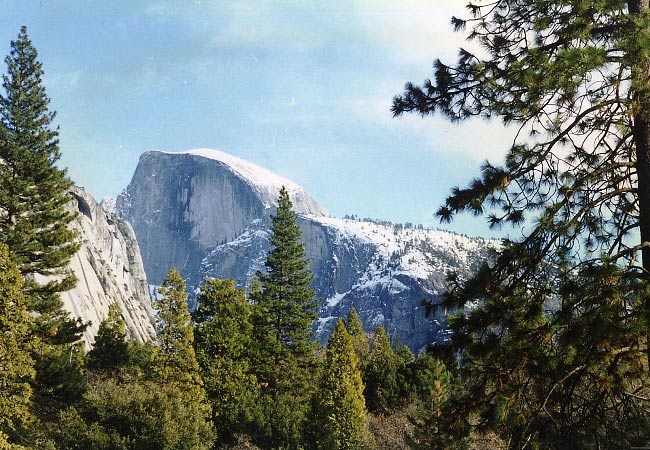
Half Dome at the head of the Yosemite Valley by Nigel Wheatley.
Grand Canyon (Arizona, USA)
The Colorado River in northwest Arizona has carved out a colourful, steep-sided canyon, nearly
450 km (280 miles) long, up to 29 km (18 miles) wide and as deep as 1830 m (6000 ft). The rocks and the fossils within them record the passage of
time, from the two billion years old granite and schist at the bottom through the remains of primitive sea plants, trilobites, primitive fish,
insects, ferns and reptiles to the 200 million years old limestone at the top. Wildlife includes California Condors which have been reintroduced
to the canyon.
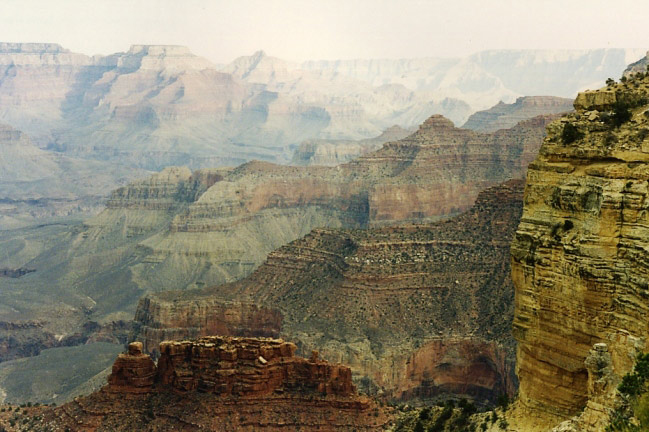
The Grand Canyon by Nigel Wheatley.
The Wave (Coyote Buttes) (Arizona and Utah, USA)
Just 20 visitors per day are allowed into this amazing lined and swirling
sandstone formation in the Paria Canyon-Vermillion Cliffs Wilderness Area on the border between Arizona and Utah; ten who reserve permits months in
advance and ten by daily lottery. There are narrow slot canyons here too but Antelope Canyon, by the nearby town of Page, is more accessible.
This slot canyon is up to 40 m (130 ft) deep but still shallow enough to allow sunlight in, to illuminate the sensuous curves and swirls of sandstone.
Arches NP (Utah, USA)
About 200 sandstone arches formed when a salt lake dried up and the rocks were subsequently sculpted by
freeze-thaw action. Landscape Arch, with a span of 89 m (291 ft), is the longest known natural arch in the world.
Monument Valley (Arizona, USA)
The isolated red sandstone buttes, some of which have vertical sides up to about 300 m (1000 ft)
high, make this vast desert valley a special place, famous for being one of the main background scenes in many ‘westerns’.
Petrified Forest (Arizona, USA)
Here wood has been turned to stone. There are thousands of logs of stone, some over 30 m
(100 ft) long, the largest number in one place in the world. It seems these giant trees were felled by storms millions of years ago and then infused
with silica from volcanic ash which then formed multi-coloured quartz crystals.
Meteor Crater (Arizona, USA)
This amazing crater left by a meteor which struck Earth about 50,000 years ago is about 1.2 km
(0.75 miles) across and 170 m (570 ft) deep.
White Sands (New Mexico, USA)
Most sand dunes are composed of the mineral
quartz but the 780 sq km (302 sq miles) of dunes here on the flat floor of the Tularosa Valley are made of gypsum, a white mineral, and, rising to
over 30 m (98 ft), they make an astonishing sight.
Mosquito Bay (Puerto Rico)
In this bay on the island of Vieques it is possible to swim through a bioluminescent 'soup' of
dinoflagellates, a fantastic experience, especially on cloudy, moonless nights.
Angel Falls (Eastern Venezuela)
When the Rio Churun flows off the edge of
the Auyan-Tepuis it forms the highest waterfall in the world, dropping a total of 979 m (3212 ft), 807 m (2648 ft) in one go.
Tepuis (Eastern Venezuela)
Tepuis are massive flat-topped almost sheer-sided
sandstone mountains. There are about a hundred in the Venezuela-Brazil-Guyana border area, rising as high as 2772 m (9094 ft) at Roraima.
The Amazon (Northern Brazil)
The largest river in the world by volume by far and the
second longest at 6515 km (4050 miles), just 180 km (110 miles) short of the River Nile at 6695 km (4160 miles), although some scientists argue the
Amazon is the longest. Even seven of its tributaries are over 1600 km (1000 miles) long. It has over a thousand tributaries, which together with the
main river hold about 20% of the planet’s fresh water, and the Amazon Basin is the largest drainage basin of any river in the world, at over 5 million
sq km (2 million sq miles). The Amazon springs from the Andes in Northeastern Peru but much of it
flows through the very wet lowland tropical rainforest of Brazil, before reaching the Atlantic Ocean.
Near Manaus, 2250 km (1400 miles) inland from the river's mouth, the two largest rivers in South America meet. Ten km (six miles) downstream from Manaus the warm, dark water of the Rio Negro, which the city is situated on, meets the cooler, muddy water of the Amazon (called Solimoes to the west) and they flow side by side and do not mix completely for several kilometres (miles). This phenomenon is known as the Solimoes-Negro interfluvium (The Meeting of the Waters).
The rainforests of the Amazon Basin or Amazonia, along with those in the Malay Peninsula and Borneo, support the greatest diversity of life in the world, although as far as birds are concerned Amazonia hosts far more than anywhere else. In some areas there are 400 bird species within 1.6 km (a mile) and over 500 within 10 sq km (6 sq miles) of certain lodges, about 50% more than comparable areas of Africa or Asia. Such lodges include Cristalino Jungle Lodge in Alta Floresta, Southern Brazil, Amazonia Lodge, Manu Wildlife Center and Tambopata Research Center in Southern Peru, and a few in the east of Northern Ecuador.
Cotopaxi (Northern Ecuador)
An almost perfectly symmetrical and still active
volcanic cone largely covered by permanent fields of ice and snow, and rising to 5897 m (19,348 ft), much higher than the neighbouring Andean peaks.
Other examples of such cones include El Misti which rises to 5822 m (19,101 ft), 2300 m (7500 ft) above Arequipa in
Southern Peru, the active Popocatepetl in
Central Mexico which rises to 5452 m (17,887 ft), Mount Shasta in
Northern California which rises to 4322 m (14,179 ft), inactive Mount Fuji which rises to 3776 m
(12,388 ft) about 100 km (60 miles) from Tokyo in Japan, and the active Mount Mayon on the island of Luzon in
the Philippines which rises to 2421 m (7943 ft).
Colca Canyon (South Peru)
This canyon near Arequipa is arguably the deepest canyon in the world, a disputed maximum of 4160 m
(13,648 ft) deep, over twice as deep as the Grand Canyon, but with less steep walls. In places it is believed to be 3.2 km (2 miles) from river to rim.
The mirador (lookout) known as Cruz del Condor where the canyon floor is 1200 m (3960 ft) below is probably the best place in the world to see Andean
Condors close up, so close in fact that at times it is possible to hear the air rushing through their outstretched wing feathers as they rise from their
nighttime roosts.
Iguassu Falls (Northern Argentina and
Southern Brazil)
These falls on the border between Argentina and Brazil may not be the highest of
the ‘big three’ (with Niagara and Victoria Falls), at up to 82 m (269 ft), but they do tumble, in what is really a series of waterfalls, over a
crescent-shaped cliff up to about 2.7 km (1.7 miles) long, making them easily the longest of the ‘big three’. They are usually at their best during the
wet season which lasts from November to March, especially December, and have even been known to dry up in May and June. The falls are surrounded by
lush forests where some spectacular birds live, not least the Toco Toucan, the largest toucan in the world, and Great Dusky Swifts, which nest behind
the falls!
Torres del Paine NP (Chile)
These three spectacular isolated towers of granite rise to
2670 m (8760 ft) at the southern end of the Andes. They are the centerpiece of the park which also happens to be the best place in the world to see
Puma, and a good place to see birds such as Torrent Duck, Andean Condor and Magellanic Woodpecker.
Southern Ocean
The roughest ocean in the world is a stirring sight in calm weather, let alone stormy weather when the scene is
completed by seabirds such as the Wandering Albatross which make light of heavy seas and strong winds. It can be experienced on cruises to
Antarctica and South Georgia, to see Emperor Penguins and on
the Atlantic Odyssey.
South Georgia
A stunning, high, snowy mountain range in the middle of the Southern Ocean, 170 km (110 miles) long, and between
2 and 40 km (1.2 and 25 miles) wide. Above the numerous glaciers the sharp peaks rise to 2934 m (9626 ft). On their slopes and on offshore islets nest
Wandering and Light-mantled Albatrosses, while the black sand beaches below are covered in Antarctic Fur Seals, Southern Elephant Seals and millions of
King Penguins, and the surrounding seas support millions more small seabirds such as prions and Snow Petrels. The island can be visited on cruises to
Antarctica and South Georgia and on the
Atlantic Odyssey.
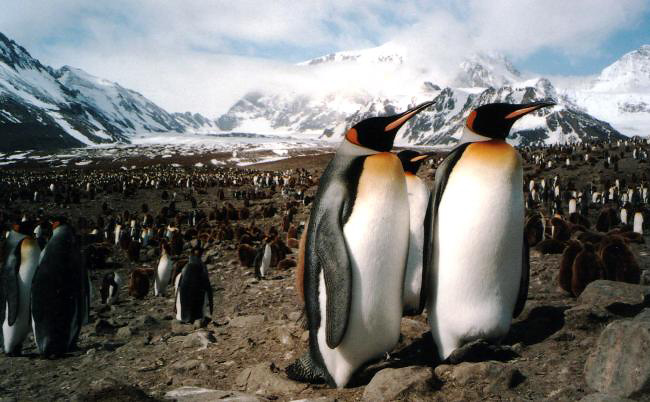
King Penguins in St Andrews Bay, South Georgia, by Nigel Wheatley.
Antarctica
Virtually the whole of Antarctica is covered with ice, on average 3000 m
(9800 ft) deep in the east, and much of the coastline is fringed by ice shelves about 200 m (650 ft) thick, as well as pack ice and icebergs, so it is,
more or less, completely picturesque. Some places are particularly picturesque though and these include the 11 km (7 mile) long Lemaire Channel between
the Antarctic Peninsula and Booth Island, an icy strait as narrow as 1600 m (5250 ft) and with walls as high as about 900 m (3000 ft), a beautiful scene
completed by Snow Petrels. Elsewhere are Emperor Penguins.
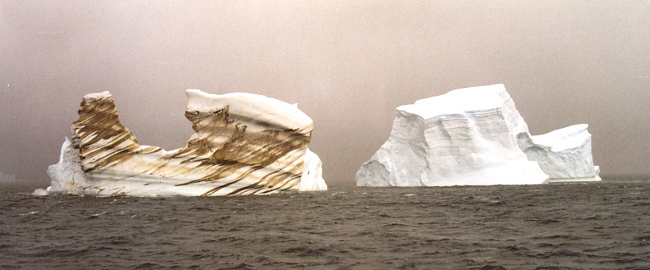
Very few icebergs have brown stripes, which possibly result from sediment being picked up by the icesheet before it reaches the sea and breaks up into icebergs. This photograph of a beautiful, rare 'chocolate ripple' iceberg was taken in the Scotia Sea between South Georgia and the Weddell Sea by Alice Perry.
Sahara Desert
The Sahara is the largest desert in the world, covering about a third of Africa, but it is only about a quarter sand.
It has vast, shallow troughs made of sand (ergs) but it is largely made up of gravelly plains (regs), rocky plateaus (hamadas) and isolated mountains. It
is the ergs which have some of the highest dunes in the world, some reputedly over 305 m (1000 ft) high (some of the other highest dunes in the world are
in the Namib Desert of Namibia – see below). Major ergs include the Bilma Erg of Niger and Chad which covers
about 455,000 sq km (175,000 sq miles). The far northwestern edge of the Sahara reaches Southern Morocco.
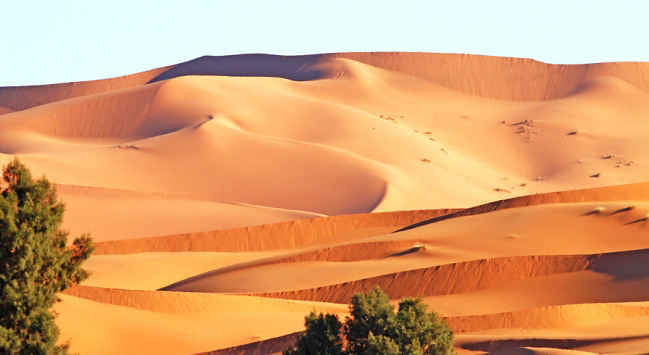
Erg Chebbi near Merzouga, Morocco at the edge of the Sahara by Chris Townend.
The Congo
The second most extensive area of lowland rainforest in the world (after the Amazon), drained by the River Congo
which springs from the highlands of Zambia and at 4700 km (2922 miles) long is the second longest river in Africa after the River Nile. This massive
area is home to such mysterious and rarely seen animals as the Congo Peacock, Bonobo and Okapi.
River Nile
The longest river in the world runs from Burundi through Lake Victoria,
Uganda, Sudan (where it is joined, at Khartoum, by the Blue Nile which springs from Lake Tana in Ethiopia) and Egypt to the Mediterranean for
6695 km (4160 miles), draining about a tenth of the African continent in the process. Some scientists believe that the River Amazon is the longest river
in the world but most agree it is 180 km (110 miles) shorter than the River Nile at 6515 km (4050 miles).
Kilimanjaro (Kenya and Northern Tanzania)
Kilimanjaro is Swahili for ‘mountain that glitters’. It is the highest peak in Africa, rising over 4600 m (15,000 ft) from the plains to 5895 m
(19,340 ft) above sea level. This inactive volcano covers an area of about 100 km (60 miles) by 65 km (40 miles) and dominates the landscape over a
huge area. Massive, isolated and snow-capped it looks especially awesome from Amboseli NP, Kenya.
Masai Mara-Serengeti (Kenya and Northern
Tanzania)
The ultimate African plains, covering about 25,000 sq km (9653 sq miles), of which about 23,500 sq km (9060 sq miles) are in the
Serengeti. This is a truly awesome place which is home to the largest gathering of hoofed mammals in the world, including over a million Blue
Wildebeest, and their predators which include Lion, Leopard, Cheetah and Spotted Hyaena. The presence of many other large animals and plenty of birds
makes this arguably the best place to see wildlife in the world.
Ngorongoro Crater (Northern Tanzania)
Not a crater but the largest complete,
unflooded caldera in the world, the result of an ancient volcano collapsing. It is a nearly circular depression with a diameter of about 20 km (12
miles) and steep slopes which rise to about 600 m (2000 ft), and an awesome setting for a wide variety of wildlife which includes some of the biggest
male African Elephants in Africa, Black Rhinoceroses, Lions and Spotted Hyaenas.
Victoria Falls (Zambia and Zimbabwe)
In the local language these falls are known as
mosi-oa-tunya which in English means ‘smoke that thunders’. These spectacular falls which can be seen close up are 108 m (360 ft) high and 1.7 km
(1.1 mile) wide, making them the highest of the ‘big three’ (with Niagara and Iguassu Falls). The amount of water varies considerably from season to
season with the most usually occurring between February and May, peaking in April.
Witsand NR (Western South Africa)
An island of white sand dunes up to 60 m
(197 ft) high, 10 km (6 miles) long and 3 km (2 miles) wide, in the otherwise red sand Kalahari Desert, trapped by a row of rocky outcrops known as
‘kopjes’.
Namib Desert (Southwest Angola and Namibia)
The oldest desert in the world has some
of the highest sand dunes in the world, over 305 m (1000 ft) high, at Sossusvlei NP, where also lies Dead Vlei, a striking white pan (dried up lake)
with stark dead Camelthorn trees amidst the red dunes. Some of the other highest dunes in the world are in the Sahara Desert – see above. The Namib
Desert is about 1600 km (1000 miles) long and up to 160 km (100 miles) wide, big and varied enough to support a wide variety of wildlife, from the
strange Welwitschia plants to the striking Gemsbok.
Spitsbergen
The largest island in the frozen Svalbard archipelago with numerous
fjords, glaciers and sharp peaks (spits) rising to a maximum height of 1717 m (5633 ft). A strikingly beautiful place completed by pack ice, Polar
Bears, Walruses and seabirds such as Little Auks.
Geiranger Fjord (Southwestern Norway)
An awesome 15 km (9 mile) long, narrow winding fjord with some sheer rock walls up to
400 m (1300 ft) high and ribbon-like waterfalls, set between snow-capped plateaus and peaks 70 km (45 miles) inland from Norway’s southwest coast. It
can be seen from cruise ships and looks equally impressive from 1500 m (5000 ft) high Mount Dalsnibba at the head of the fjord. It is still not the
longest and deepest fjord in Norway though; that is Sogne Fjord, about 70 km (45 miles) north of Bergen, which is 204 km (127 miles) long, up to 1308 m
(4291 ft) deep and about 5 km (3 miles) wide in the main channel.
Armand Cave (Southern France)
This cave near the Camargue in the south of
France is about 75 m (250 ft) below ground in a chamber about 100 m (325 ft) long and 55 m (180 ft) wide. In it is a ‘forest’ of ‘branched’ stalagmites,
400 in all, rising to 30 m (100 ft).
Cirque de Gavarnie (Southern France)
This massive ice-carved cirque in the
high French Pyrenees is 3.2 km (2 miles) across with steep walls between 500 m and 700 m (1640 ft and 2297 ft) high, and a 422 m (1385 ft) high
waterfall. Along the rim is an impressive sheer-sided gap, known as the Breche-de-Roland, at 2800 m (9200 ft). Dominated by three peaks over 3050 m
(10,000 ft) the mountain beauty is completed by many wild flowers, butterflies such as Apollos, big birds for the big country such as Lammergeiers and
Eurasian Griffon Vultures, and small birds such as the unique Wallcreeper.
Lauterbrunnental (Switzerland)
To the south of Interlaken on the edge of the Bernese Alps in south-central Switzerland lies
what is arguably the most beautiful high Alpine Valley. Its sides rise to 450 m (1500 ft) and they are graced by about 20 cascades, the loveliest of
which is probably the nearly 300 m (1000 ft) high Staubbach Falls.
Guilin Hills (Southern China)
These strange stands of conical limestone towers, rising to 120 m (394 ft), lie alongside the
paddy fields by the banks of the Li River. The best are downriver from Guilin around Yangshuo, where they look particularly beautiful from the top of
Yueliang Shan for example, and at Xingping, where they may be viewed by boat. Similar towers can be seen at Along Bay on the Vietnamese side of the
Gulf of Tongking.
Himalayas
The Himalayas cover an arc which is 2,400 km (1490 miles) long and up to 400 km (250 miles) wide. Within this area lie
over a hundred mountains higher than 7200 m (23,622 ft) or higher than the highest peak in the Andes, Aconcagua in Argentina, which rises to 6962 m
(22,841 ft). The two highest peaks are Everest in Nepal which rises to 8848 m (29,029 ft) and K2 in the
Karakoram of Northern Pakistan which reaches 8611 m (28,251 ft). It is possible to trek to Everest base camp to see the mountain, from Lukla or via the
Makalu Trek, from which it is possible to see four of the five highest mountains in the world; Everest, Kangchenjunga, Lhotse and Makalu. It is also
possible to trek to K2 base camp. One of the most beautiful sights in the Himalayas is from Pokhara in Nepal. From there the Annapurnas may be seen; an
isolated 50 km (30 mile) long ridge with four sharp peaks between 7507 m (24,630 ft) and 8091 m (26,545 ft) high, including the tenth highest mountain
in the world, Annapurna I.
Wave Rock (Western Australia)
A beautiful overhanging ridge of granite about
110 m (361 ft) long and 15 m (49 ft) high sculpted into the shape of a wave by wind and water about 350 km (220 miles) from Perth.
Uluru (Ayers Rock) and Kata Tjuta (The Olgas) (Australia)
Uluru is the largest monolith in the world. Rising 348 m
(1142 ft) from the surrounding desert to 863 m (2831 ft) above sea level and measuring 8 km (5 miles) around its base it is visible from over 100 km
(60 miles) away. It’s the bare ‘bone’ of a sandstone mountain which has been whittled down over millions of years mainly by wind-blown sand. Mount Olga
rises 546 m (1791 ft) above the surrounding desert to 1066 m (3497 ft) above sea level. It is part of a group of 36 red domes known as The Olgas or,
in Aborigine, Kata Tjuta (‘many heads’). They cover about 22 sq km (8.5 sq miles) and lie about 25 km (15 miles) west of Uluru.
Great Barrier Reef (Eastern Australia)
The largest structure ever built by
living things (stony corals) is over 2000 km (1243 miles) long and covers 207,000 sq km (79,923 sq miles). It is not actually a single reef but
consists of thousands of smaller reefs, built over the course of about 18 million years. An astonishing variety of multicoloured and multipatterned
fish live around these reefs along with turtles, and the birdlife includes nesting seabirds such as Sooty Terns.
Milford Sound (New Zealand)
A spectacular fjord 3 km (1.9 miles) wide and 19 km
(11.8 miles) long with mountains alongside which rise to 1690 m (5545 ft), on the southwest coast of South Island. Nearby the peaks reach 2756 m
(9042 ft) and the Sutherland Falls fall 610 m (2001 ft).
Bora-Bora (near Tahiti in French Polynesia)
The classic Pacific atoll; an extinct,
sunken volcano encircled by a shallow, sandy lagoon and encircled by long, narrow coral islands (motus), about 200 km (125 miles) northwest of Tahiti.
The main island, in the middle of the lagoon, is up to about 8 km (5 miles) long and up to 5 km (3 miles) wide, rising to 727 m (2385 ft). It’s a
beautiful scene and to cap it all Bora-Bora is also one of the best places for scuba-diving and snorkeling in the world. Other beautiful Pacific atolls
include Aitutaki in the Cook Islands.
Hawaii Volcanoes NP (Hawaii)
Within this park on Big Island lie Mauna Loa, the largest
active volcano in the world which rises to 4169 m (13,679 ft) and has a summit crater about 5 km (3 miles) long and 2.5 km (1.5 miles) wide, and Kilauea,
one of the most currently active volcanoes in the world. When the lava is flowing out of Kilauea, down its slopes and into the ocean, it makes one of
the most spectacular natural wonders in the world.
The top destinations where the highest number of Our Top 50 Other Natural Wonders which are site-specific are present are Arizona in the USA (5 plus one in nearby Utah and another in nearby New Mexico), Antarctica and South Georgia(3), Northern Tanzania (3), and Kenya, Southern France and Eastern Venezuela all on two.

